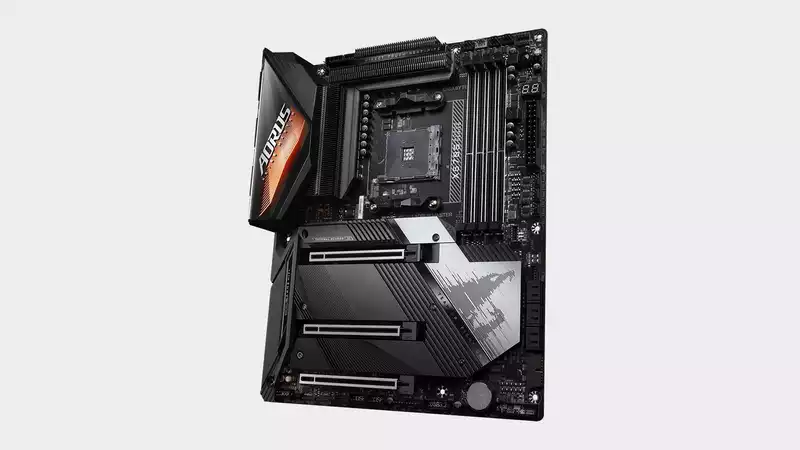The X570 chipset may be a couple of years old, but that doesn't mean it's time to put it out to pasture just yet; with PCIe 4.0 lanes, you can easily add features for 2021. That's exactly what Gigabyte has done with the X570S Aorus Master, which shares much in common with its already acclaimed 2019 predecessor and includes several major feature updates and design tweaks that make it an AMD mother It should remain a best-in-class contender for boards.
One of our concerns when we first saw the X570 board at Computex 2019 was the near-universal presence of chipset fans: a 15W TDP combined with the heat generated by several PCIe 4.0 drives, thankfully not always The S in X570S stands for quiet. While the basic chipset design remains the same, Gigabyte has added more surface area to the cooling assembly, with almost the entire bottom half of the board covered by a heat sink.
Gigabyte's high-end boards tend to be fairly similar: the X570S Master is black with just a bit of RGB over the I/O section. If more RGB is needed, there are five RGB headers, two of which are addressable, ten fan/pump headers, a Type-C USB 3.2 Gen 2 header, and power and reset buttons.
The X570S Master is one of the few boards with four M.2 slots. Of note is the raised M.2 heatsink at the very top. Some M.2 drives run really hot, so a little extra surface area on the heatsink is a welcome addition. six legacy SATA ports have been added to the M.2 ports.
Gigabyte deserves credit for continuing to use finned VRM heatsinks that increase surface area. Proving that a blend of function and form is possible, the 14-phase VRM with 70A MOSFETs is enough to power the LN2-cooled 5950X with plenty of room to spare.
Gigabyte audio implementations usually impress, and the X570S does as well. But gamers who listen to bullets and bombs instead of Bach will be satisfied, thanks to the ALC1220-VB audio codec, ESS Sabre Hi-Fi 9118 DAC for headphones, and Chemicon and WIMA audio capacitors.
The rear I/O is more than adequate, especially when it comes to USB connectivity: four USB 2.0, two USB 3.1 Gen 1, five USB 3.2 Gen 2, and one Type-C USB 3.2 Gen 2x2 port for a total of 12 ports. Something must be done about this ridiculous USB nomenclature, but that's another story for another time. There are clear CMOS and BIOS flashback buttons, an antenna connector, a standard audio port with S/PDIF, and finally one Intel i225-V 2.5G LAN port.
At this price, we would like to see a 5G option. Additionally, the non-S Aorus Master had dual LAN. However, with Wi-Fi 6 and 6E in widespread use, dual LAN and gigabit are not as important as they once were.
System Performance
The X570 platform is mature enough with years of AGESA updates. There are usually few surprises regarding performance; anything other than a 1-2 % difference would raise eyebrows. We have set the processors to their default state and disabled all core-boosting technologies.
Gaming Performance
The X570S Master proved to be fairly average in single-threaded performance, but quite powerful under multi-threaded loads. Gaming performance is as expected, albeit within the margin of error. Strong M.2 SSD performance was also demonstrated.
The X570S Master's VRM cooling impressed us, and it showed in our tests: with PBO enabled on the 5800X processor, the peak VRM temperature was only 48°C. This is 5°C lower than our recent test with the ASRock X570S PG Riptide.
The X570S Aorus Master is priced at $389, placing it below high-end AMD motherboards. If you already have an X570 board, the answer is "no."
But if you're holding off on upgrading, for example, and are looking for something upscale to pair with a high-core-count processor (which is readily available now), this is definitely worth a look. if AMD releases a Zen 3+ refresh or V-Cache model within a few months to be released, the premium-class X570S board will be the first to support it.
But there is a flip side to this: AM4 is in the twilight of its venerable career. We are looking at Zen 4, Alder Lake, and DDR5. But there is always something over the horizon. But if you are switching from something older like a B350 or Z170 system and need more cores or PCIe 4.0 support, you will certainly see a big jump.
The Aorus Master is loaded with features that keep AM4 and X570 fully associated and up to date. It looks good too, and while a board around $400 is not exactly affordable, we feel it offers a good feature set for the price.
If you are looking for the last AM4 motherboard, the X570S Aorus Master is worth a look.
.

Comments